So I bought a Sapphire Nitro RX 470 8GB Mining Edition card a year or so ago that arrived DOA. After many hours of troubleshooting, I found the problem was two blown fuses and and a bad Smart Power Stage. Please Google “RX 470 Mining back from the dead - zombie edition” for the full story on TPU complete with screenshots. Long story short, I did not have the skills to replace the Smart Power Stage, so I simply removed the corresponding choke to disable the power phase. I’m running on three out of the four 50A phases right now and the card works great.
With the one phase disabled , it ran at 300MHz, but by hard-coding clocks and Voltages using Polaris BIOS Editor I got to 751MHz and then 1100MHz+. I noticed in GPU-Z and HWInfo that the card thought it was using over 300 Watts and over 300 Amps 
With a missing power stage, I assume the card had miscalculated its power usage and had thrown itself into a serious limp mode. By raising the allowed power limits to something above what the card thought it was using, the card allowed itself to function normally, albeit with 75% of its normal power. I easily get to 1206MHz at 956mV and the card’s ASIC Quality is 77.0%/64.4%. I can even overclock it, but I typically don’t. The card has an eight-pin PCIE power connector.
My question is this: With the card thinking it’s using over 300W and 300A, how do I pick sane limits in the Powertune section of PBE? Do I just run a benchmark or a game and see what HWInfo records as the maximum Amperage/Wattage used, then pick numbers that are a few percent higher? Or is there a way to edit the BIOS or voltage controller to tell the card that it really only has three power stages so that the power use computed is actually correct? Per @ket 's sticky post, the little NCP81022 might not get much love, but I’m pretty impressed it’s coping really well with the missing power stage.
Thank you all for reading. If you or anyone you know on this board might have an answer for this intriguing question, I’d love to hear it.
@katapaltes I haven’t logged in to TPU in years heh, but based on what you say here taking the hwinfo64 readings isn’t going to be much good the entire card is going to be miscalculating its power usage most likely due to that missing phase, as far as the card is concerned its still there because the NCP81022 is capable, but very dumb. If you had an IR35201 on there the card most likely would not be working right now. Power from the PCI-E slot and 8pin PCI-E cable would normally give you a total of 225w but with that missing phase (and I assume the card is phase doubled - its sapphire, they do that shit a lot) one doubler is still trying to “ping” that missing phase for load balancing. If you’re sensible with how much voltage you send to the core, lets say a maximum of 1.1v, that missing phase shouldn’t be of any concern as the card will never exceed the physical capabilities of the remaining phases. Without knowing the necessary resistances I can only give some rough numbers but basically to remain stable on the remaining phases youre going to be looking at capping the card to somewhere around 180w at a push. Good news is that you have a high ASIC quality so you aren’t actually going to need a huge amount of voltage for a solid OC, 1.05v should see you getting to somewhere around 1.3-1.35GHz.
EDIT: Attach a copy of your vBIOS and I’ll be able to iron a few things out so you’ll be able to see what you can change, what doesn’t need changing, what can be considered maximum safe limits for the moment, stuff like that.
Hi ket, and thank you for those details. I feel grateful to have a dumb voltage controller at this point, because there’s no way I’ll be able to replace that FMDF3035 Smart Power Stage. I don’t think the card has any phase doublers (see pic below), but I could be wrong.
So to make things more confusing, the card is a used mining card that arrived with a tweaked BIOS. I went to TPU and downloaded the best fit I could find (RX470, 8GB Micron RAM, Mining, yada yada yada) and that BIOS worked well, albeit at only 300MHz. It’s attached as 209467-rx470-8gb-orig-from-TPU.zip. As mentioned above, I later edited that BIOS to bump two Wattage settings to 369 and one Amperage setting to 396 in the POWERTUNE section of Polaris BIOS Editor, and that file is attached as Ellesmere-369-396-369.zip.
The two attached BIOSes (they’re basically the same) top out at a modest 956mV in State 7, which seems to work great for the 1206MHz default clock. If I drag the Power Limit in AMD Settings all the way to 50%, I can OC the card to 1337 MHz and it’s stable in games. Side note: I did try the bypass driver check hex edits from your sticky and they worked, but the card then thought it was an RX 580 with higher voltages (scary with my gimped card), so I flashed back to my previous BIOS. I haven’t tried any other BIOS mods from your thread like memory stuff, etc., but it all looks very interesting.
Anyway, thank you again for your response. I’m pretty happy with where the card is now, but if you have any further safe mods, I’d be keen to try them. ![]()
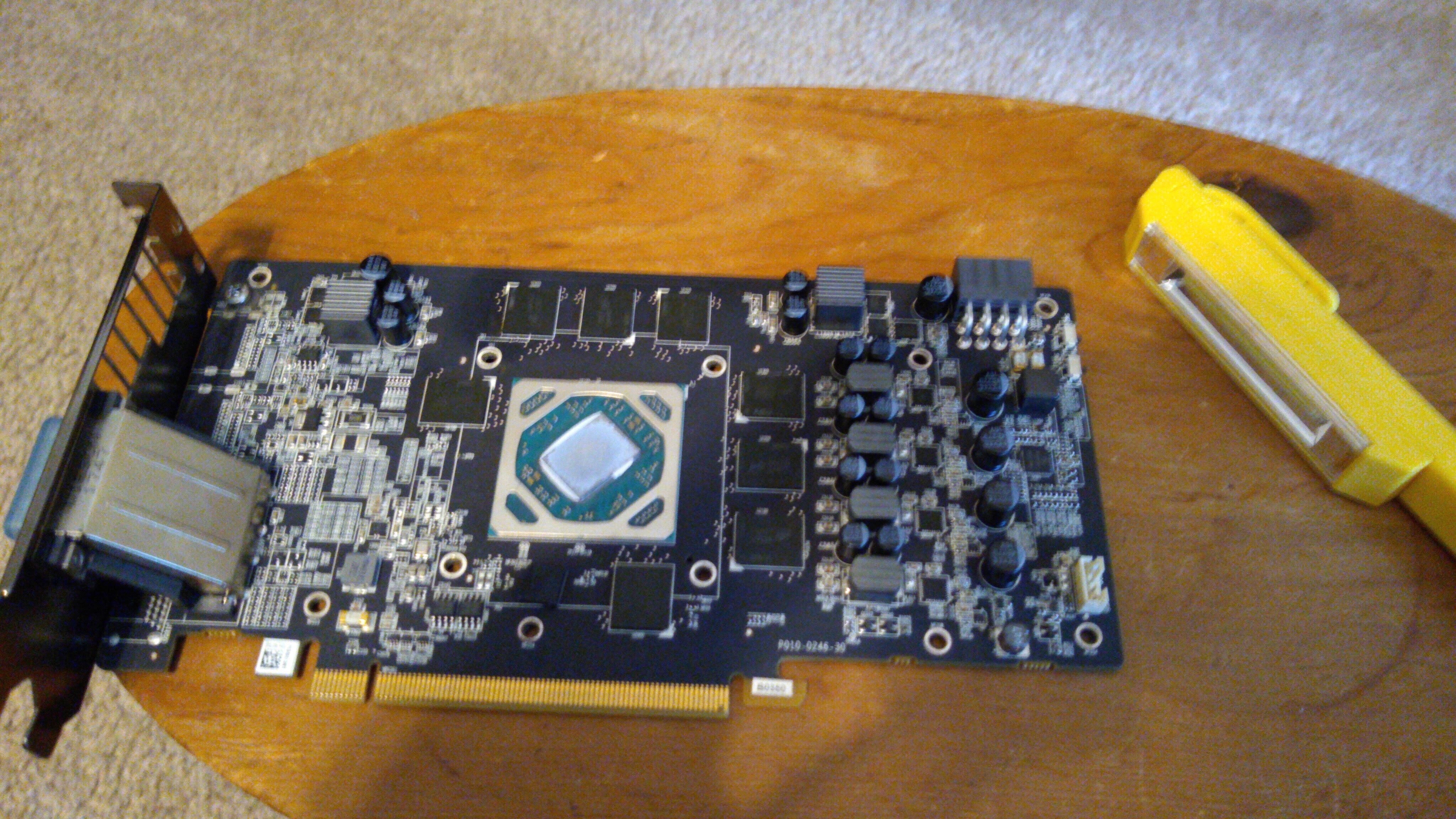

209467-rx470-8gb-orig-from-TPU.zip (110 KB)
Ellesmere-369-396-369.zip (110 KB)
@katapaltes I can’t tell much with the pic you attached as its really blurry. Phase doublers are usually on the opposite side of the PCB anyway ![]() As a general overview the card doesn’t look like its a mining version at all, actual mining cards don’t have display outputs but some retail cards in the beginning were repurposed with “special” mining vBIOSes so yours is quite likely a regular card that some miner just buggered about with and half murdered. The reason the vBIOS level driver bypass upped voltages is because you need to make more changes than just the bypass itself so max volts aren’t just thrown at the card. AMD RTG were really, REALLY stupid there setting auto voltages to the same limit as manual voltages which means even at stock frequencies the cards defaulted to max volts because the algorithm was/is too stupid to tell any difference (this is why people like to always vBIOS mod your cards, AMD RTG). With proper tuning though a 4/500 series card can be quite power efficient I have an 8GB RX470 Nitro+ in my retro rig that does 1.32GHz on 1.04v
As a general overview the card doesn’t look like its a mining version at all, actual mining cards don’t have display outputs but some retail cards in the beginning were repurposed with “special” mining vBIOSes so yours is quite likely a regular card that some miner just buggered about with and half murdered. The reason the vBIOS level driver bypass upped voltages is because you need to make more changes than just the bypass itself so max volts aren’t just thrown at the card. AMD RTG were really, REALLY stupid there setting auto voltages to the same limit as manual voltages which means even at stock frequencies the cards defaulted to max volts because the algorithm was/is too stupid to tell any difference (this is why people like to always vBIOS mod your cards, AMD RTG). With proper tuning though a 4/500 series card can be quite power efficient I have an 8GB RX470 Nitro+ in my retro rig that does 1.32GHz on 1.04v 
![]() You’re giving the card permission to try and draw X amount more power when required than what the VRM is specced to handle which will in the worst case (furmark for example, nobody should use that murderware) will literally cause the VRM to blow up.
You’re giving the card permission to try and draw X amount more power when required than what the VRM is specced to handle which will in the worst case (furmark for example, nobody should use that murderware) will literally cause the VRM to blow up.
Theres definitely a fair few tricks I can work on your card to smooth some things out, make some quality of life improvements, and get a rather healthy performance boost out of the card. As I’m not sure if your card is meant to be a Nitro or Nitro+ I’ll modify the custom vBIOS I made for my Sapphire 470 as it contains many of the changes I’d make for your card already. You might need to use the command prompt version of atiflash to override some basic stuff so I’ve included that too. I’ve also changed the memory timings for Micron to my own custom strap that is good for 2200MHz at least. If your card can’t handle high frequencies like that I can optimise the strap for a lower maximum frequency. Because power readings are off on your card you might see throttling with this vBIOS easy to fix if soI’ll just need a way to work out roughly what your card is actually drawing then use a value that offsets by the amount the card is wrong by. It’ll be a good idea to wipe out the driver with DDU from safe mode as the AMD driver borks itself pretty easily when you start changing memory timings which can lead to poor performance until a clean sweep and reinstall is done of the driver. Alright, I think, thats everything. For now anyway 
EDIT: An interesting test would be to see if the card can run Tomb Raider in DX12 without crashing, that game seems to work all of the power stages pretty hard so if the card isn’t getting enough power TR will crash out.
ZombiesAreReal.zip (394 KB)
Looks like I’ve got my homework. 
I’ll attach a better pic copied from my TPU thread that shows the removed inductor (and some passive components dislodged by my hot air station - oops). I don’t have a pic of the back of the card handy, but the only things on the back of the card are tiny passive SMD parts, and I imagine phase doublers are bigger than that.
Since you previously mentioned I could probably go as high as 1.1V with my three remaining phases, I may want to try out your 1.04V @ 1.32GHz… Here’s a burning question I’ve never been able to find an answer to: I’m running 956mV for State 7 and can get to 1337 MHz by bumping the AMD Settings’ Power Limit to +50%. So which is better, upping the Power Limit to get to 1337 MHz as I’ve done or setting a Voltage of 1.04V to get to the same speed as you’ve done?
Also, if you don’t mind my asking another question that’s been vexing me: Would running at 2000 or even 2200 MHz RAM help with gaming, or is that mainly a benefit for mining?
I was hoping you meant Tomb Raider from 2013 as I actually have that on Steam. But I checked just now and that version didn’t run DX12. But I did run Furmark nervously a couple times without it crashing and then uninstalled it after hearing all the bad feedback on it.
Thanks for your detailed responses. ![]()
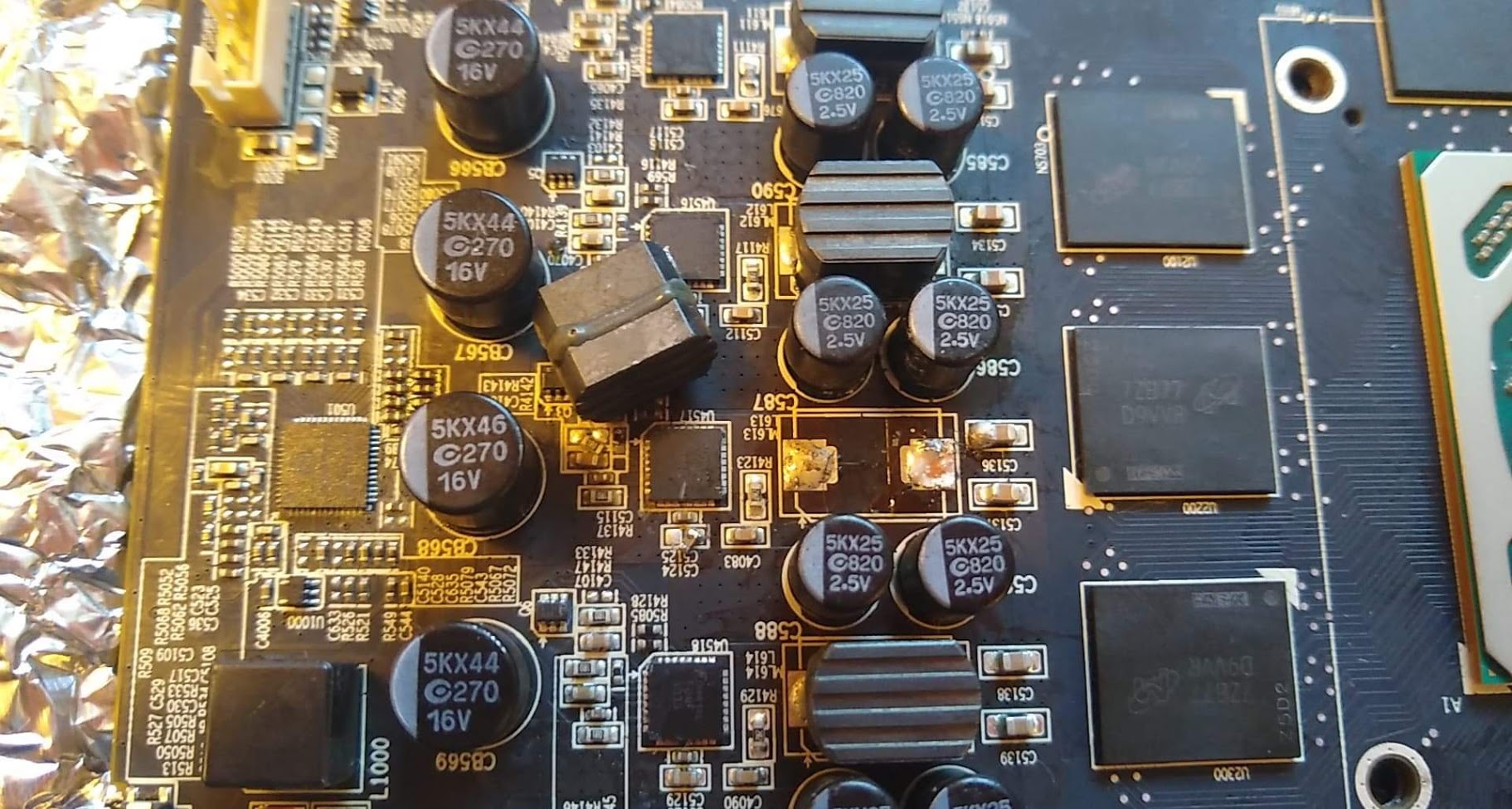
@katapaltes Yup thats an actual mining card then, not terribly different from a retail card though that one aside from missing a bunch of display outputs. I’ll modify the vBIOS you found on TPU as a backup in case the retail varient firmware doesn’t want to play nice.
Nope, phase doublers are actually pretty small. Think of them as a middle man that needs to pass a message on to two different people. Typically you’ll have one phase doubler for two phases to "technically" make a 4 phase VRM 8 phase for example. I don’t actually like phase doubling at all I have nothing against the concept but I don’t like it because it allows manufacturers to claim retarded things like "16 phase!" when in reality, 9/10 times, its 8 phases doubled for "16".
First part of that question is a bit double edged. With more voltage comes more heat and power draw, without an increased power draw allowance the card will bump into the predefined TDP making it throttle more often. Best thing to do when increasing voltage is to also increase TDP and maximum power limit. I’ve already done that in the modded firmware so for the moment anyway it shouldn’t be anything you need to worry about. Second part of that is simpler to answer but still a bit double edged, at a stock 2000MHz you can optimise memory timings to the point of you’ll get about the same performance as a memory OC + optimised timings the benefit in games of the memory OC + optimised timings is that some game engines are sensitive to both raw MHz and efficiency which is why even though it takes bloody ages I optimise my timings for maximum stable frequency and efficiency.
Small history lesson: I did that for an RX580 and RX590 and the end result for the RX590 was very disappointing, all the extra GPU frequency it had (+125MHz, or 1.55GHz vs. 1.425GHz on the 580) made absolutely zero difference to performance they were well within margin of error so moral of the story here is that if you have an RX580, give it a GPU and memory OC, optimise the memory timings and it’ll perform exactly the same as even a highly optimised RX590. Its a similar story for the RX470, the one in my retro rig scores about 4200 in the FFXV bench at 1080p with max settings and all the nvidia stuff disabled (except for hairworks) compared to all the tuned RX580s and 590s I tested you’re only down about 600pts, maybe 700pts if you get a silver or golden sample, which is only equal to about 4-5FPS average difference. Even now I still say if Polaris was put on 7nm for power efficiency improvements and fitted with GDDR6 memory it is very possible with proper memory timings you’d seen another 20% (perhaps more) performance improvement as Polaris is a REALLY bandwidth starved architecture.
Nah I mean Shadow of the Tomb Raider, there was a demo of it you could download on steam, its probably still there.
Here you go @katapaltes fully modded up vBIOS of what you found on TPU its pretty much the same as the vBIOS I modded based on my retail 470.
ZombieMod.zip (107 KB)
OK, I downloaded the demo for Shadow of the Tomb Raider and was able to play without any issues for ~15 minutes on my existing vBIOS (956mV at 1206MHz). I didn’t try overclocking while playing, but I’ll try that next to see if I can force an error.
The first vBIOS (from the bundle of files in your post #4 above) didn’t seem to work for me. Windows wouldn’t recognize the card in Device Manager even after DDU/driver reinstall (and just for grins, atikmdag-patcher). I then moved on to the second vBIOS from your post #7 and that one worked. Note: I did have to edit that vBIOS in PBE and raise the limits in the Powertune section to 300+ Watts/Amps because if I didn’t, the GPU clock would only run at 300MHz (see below for pics without/with raised power limits). I think I’ll stay with your second BIOS with the raised power limits for now. ![]() Many, many thanks for all your help. I’ve had a lot of fun and heartache and learned quite a bit from the 40+ hours I’ve spent working on this card.
Many, many thanks for all your help. I’ve had a lot of fun and heartache and learned quite a bit from the 40+ hours I’ve spent working on this card.
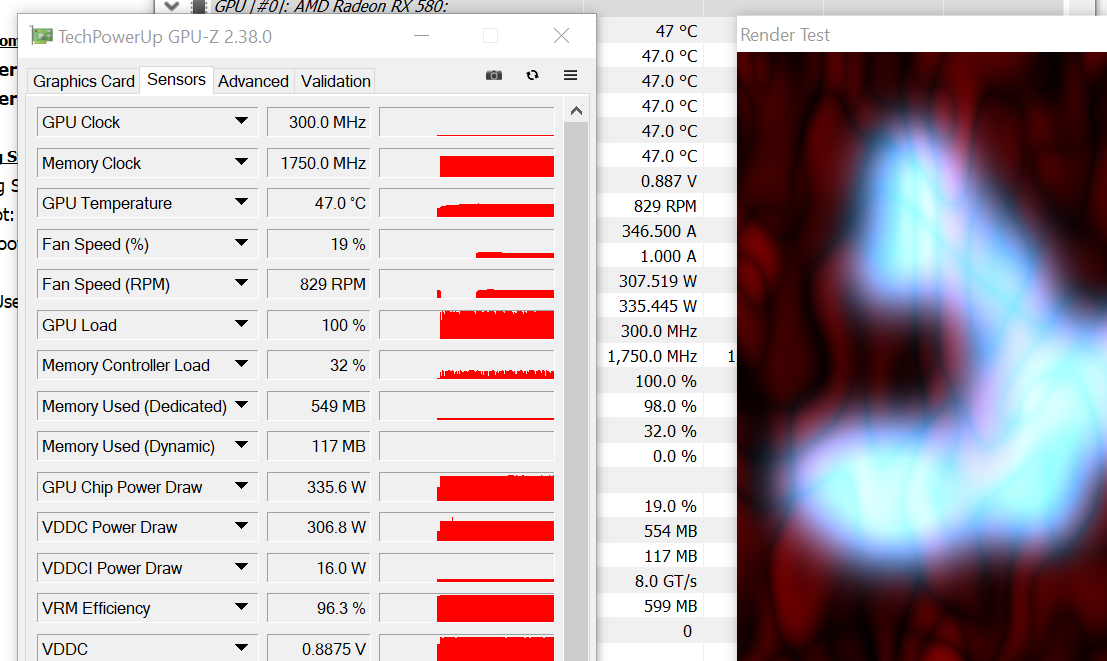
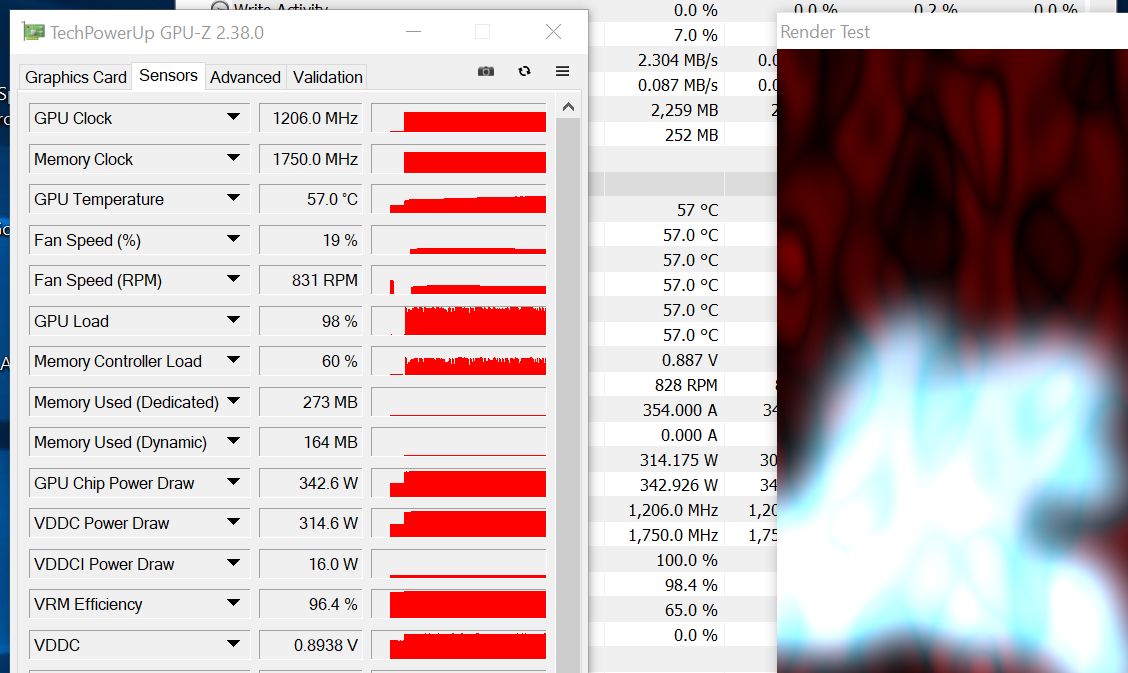
If ever you want to get some more performance out of that card @katapaltes you could edit the memory timings. Depending on the maximum OC you can get on the memory (I’m going to guess you’ll top out around 2000MHz) you can try changing TRP_RDA to 26/27, TRP_WRA to 55/56/58, and TRRD to 6. TCL you might be able to lower to 20 but TCL doesn’t do much to improve performance its linked much more to stability, set it too low and you’ll start getting screen blackouts, gray/green screens, etc. All the other timings are in their sweet spot for balancing frequency, performance, and OC potential, in fact you shouldn’t lose a single MHz on your memory OC even if you make some of the suggested changes as the timings I’ve used weren’t meant to be final just something to work with so you could discover your max memory OC ![]()
@katapaltes @ket Hi guys ! I could really use your expertise with the problem I have with my Asus RX470 mining card . The thing is that this card only work if the TDP is under 75 watt , as soon as it try to go above 75 watt the amd driver will crash and restart itself in a couple of seconds ! So right now I had to underclock the card to 800 Mhz core and 1350 Mhz memory speed and it runs just fine , but it would be nice if you could help me find the faulty component that caused the problem !
I tried to force Vcore to stay at 1100 mV but when I try to run any 3d task (game or furmark &…) it will drop to under 700 mV in stock clock and I think that make the driver to crash . I’m guessing it has to be a power stage problem .
[[File:Screenshot (22).png|none|auto]]
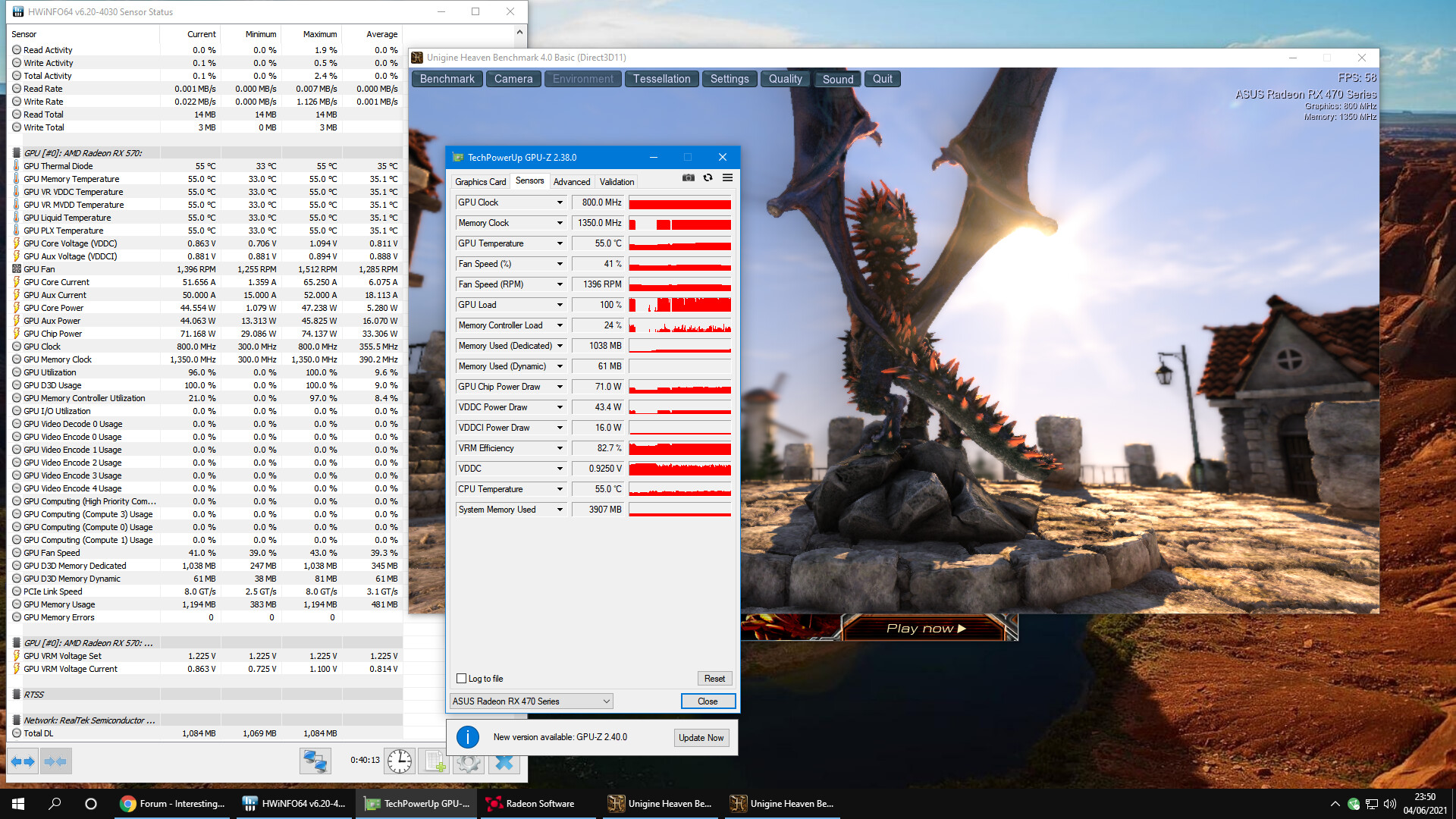
@sam6o9 I’ve never seen or heard of a problem like that all the Polaris cards I’ve worked with are gaming cards so without knowing exact details about your card I couldn’t say, it could be something as simple as the card being power limited in its vBIOS or Asus might have designed the card with low power usage only in mind (one way among many to reduce production costs) or there might be an actual physical problem with the card or your PSU, just don’t know enough details. If I had to guess the problem might be incorrectly set VDDCI as if the driver expects one value but gets another where its not been changed in all the right places that will make the driver BSOD.
@sam6o9 Sorry, I only just now noticed your post when I came back to review some of ket’s comments. If you haven’t already, re-flash the video card BIOS to get it back to factory defaults. If you got it second-hand from a miner, there’s no telling what settings have been changed. Hopefully you can download the BIOS from Asus’s site, or if you can’t find it there, contact them via email/chat/whatever and ask them for one. If they can’t help you, you can visit techpowerup.com and search for the correct video BIOS in their database. If you can’t find a BIOS that matches your card exactly or if you find one and it doesn’t help, you can find the forum there where others have asked exactly for this kind of help. If you can provide them with pics and/or details of the exact model number and the brand of memory used (from GPU-Z), they can usually locate a BIOS. They may even be able to find a non-mining BIOS that will make the card work like a regular, consumer card. <- I’m assuming you want the card to work for gaming/general purpose and not for mining.
I’d consider doing the above before diagnosing the card for a dead power stage, unless you have training or friends in that field.
I’d just go straight to the GPU database, you likely won’t get an exact match for your card as vBIOSes can vary by batch but you should get something thats like a 99% match.
a good solution

